A nearly blinding rainstorm was pounding down on our pickup truck's windshield as we drove west through the intensely curvy I-40 Pigeon River gorge, from North Carolina into Tennessee. Although it was only 5:30 in the morning and eerily dark, the 18-wheelers were already out in force making it all the more difficult for us to see the highway through the spray their big tires kicked up. So, what would have Chrissy and me leave behind our cozy warm bed so early in the morning to travel down a dangerously dark and slippery highway? The rocks were calling, of course!
Our plan for the day was to join our friend and noted mining geologist, Travis Paris, in a hunt for fluorite, barite and associated minerals in East Tennessee. Joining us in our quest was Bill Hayward, Jeff Deere, Jim Flora, Cheryl Cornell and Janice Erickson . . and of course, our ever popular but sometimes whiney dog, Opal. We all met bright and early at the Mickey D's in Sweetwater.
Travis, who has probably forgotten more East Tennessee geology that I will ever know, is familiar with a series of abandoned barite mines in what is referred to as the Sweetwater district. The Sweetwater district is composed of three sub-parallel strike belts of rocks of the Knox Group in Loudon, McMinn, Monroe and Roane Counties. There are reportedly a total of 112 abandoned barite mines and prospects in the district. Tennessee barite production began about 1870 and continued until around 2002, with the last mine being operated in McMinn County by the Yates Construction Company. All barite mining in the Sweetwater District was in residual deposits derived from the weathering of solution collapse breccias cemented with barite and other minerals. Weathering reduced the hard rock to barite-bearing clays allowing for low-cost excavation and simple separation. Mining generally ceased once the bedrock was encountered, as it was not economical to continue. Bedrock at some of the old mines not reclaimed contains voids partially or entirely filled with barite, fluorite and other minerals.(1)
The principle minerals associated with Sweetwater district barite include fluorite, smithsonite, limonite, galena, and pyrite. Combination specimens with pale green to dark purple fluorite with cubes up to 3/4-inch, white barite "balls" and a smattering of sparkling white smithsonite are perhaps the most sought after ones by rockhounds.
The rain began to subside as we caravanned behind Travis out of town. We followed him to an abandoned mine in the heart of the Sweetwater district. By the time we parked, the rain had completely stopped so that it looked as though we might stay dry - at least for a while. The location is on private property, but Travis gained the trust of a landowner who graciously allowed us to collect there for what would essentially be a one-shot deal. Although the mine is heavily overgrown in a dense forest, there are plenty of left-behind boulders to bust apart with hammer and sledge. Janice put out the word that she'd be accepting any micro specimens that the rest of us didn't want to keep, so she and Travis "set up shop" on the slope above where the rest of the group was working.
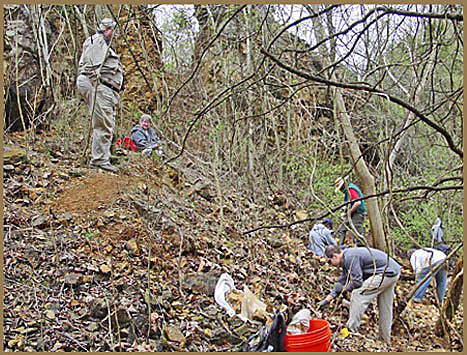 The group minus the author/photographer
The group minus the author/photographer
As the day progressed, there were plenty of micros that were either picked up by or delivered to appreciative Janice and Travis. It was great fun to have the cheerful duo pretty much on-call to identify and explain any unknown minerals that we came across.
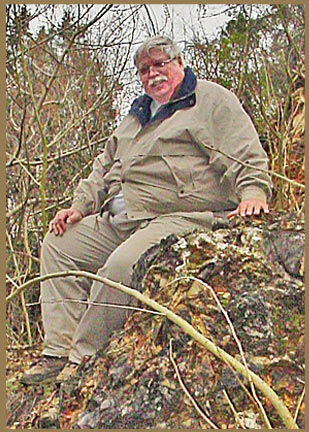
Travis Paris
|
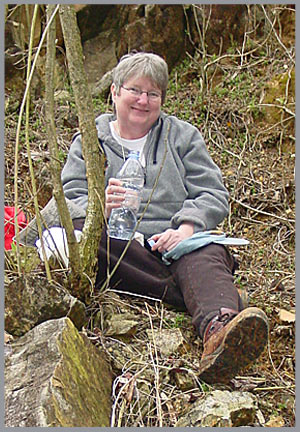
Janice Erickson
|
We spent the remaining morning and most of the afternoon turning big rocks into smaller ones. Everybody managed to recover some keepers along the way, so there was no shortage of smiles.
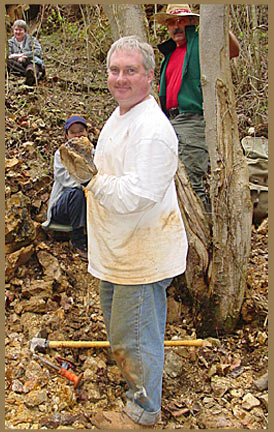
Jeff Deere
| 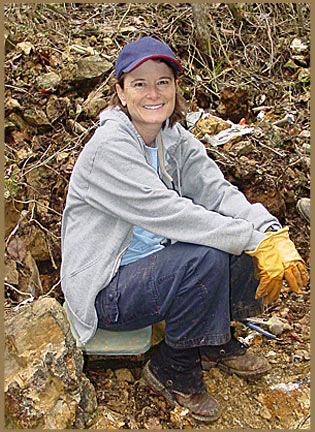
Chrissy Streeter
|
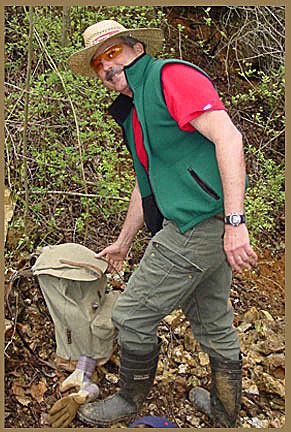
Jim Flora
| 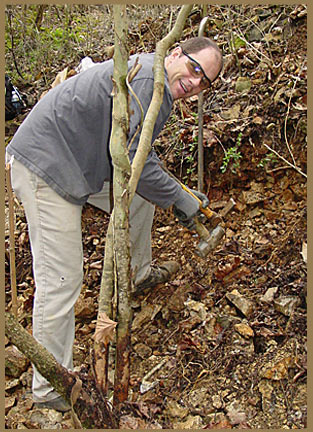
Bill Hayward
|
By mid-afternoon, just about the time everybody was starting to wind down, the rain returned. A few drops followed by a moderate drizzle were all the convincing we needed to call it a day. But a gentle soaking couldn't dampen our enthusiam for the beautiful specimens that we recovered; some are pictured as follows.
Click on each specimen picture to enlarge
Click on each specimen picture to enlarge
Our thanks to Travis for including us in such a terrific rockhounding opportunity!
Reference(1): Stuart W. Maher, Barite Resources of Tennessee, Report of Investigations 28, Tennessee Division of Geology, Nashville, TN, 1970.
CLICK THE LITTLE MINER TO RETURN TO THE FIELD TRIP PAGE
